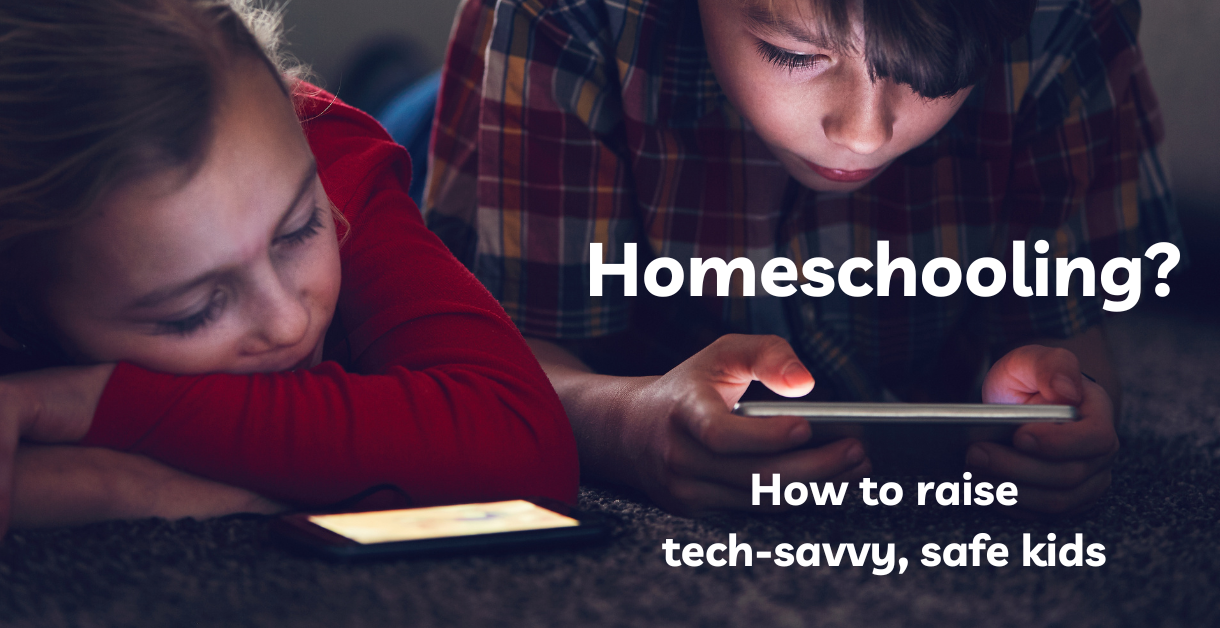Digital parenting is far from easy, teaching kids how to stay safe on devices they often look more comfortable on than us. For homeschoolers that responsibility is doubled, with an expectation that online safety is woven into their education.
What do kids need to know about online safety?
Online safety can feel overwhelming because there are so many different games, platforms and devices that our kids use, and it covers such a wide range of topics, so where to begin?
Firstly, kids need to know that you are on their side! Even though we know that devices can be the cause of much frustration and discord, it’s important that we parents and carers stay involved in their digital world. That may seem obvious advice, but it helps to communicate this clearly during online safety conversations. Your child should know that they can talk about anything they experience on screens and that you’ll listen to them without judgement.
As your kid’s homeschooling parent, do you feel equipped to give them the knowledge they need to set them on their digital way? Well, it doesn't really work like that. Online safety is not a lesson you teach and move on to other subjects; whenever your child is on a connected device, they are vulnerable to online harm. Kids need to develop ongoing critical thinking skills to make positive choices in the digital world.
How to encourage learning through ‘doing’
It is natural to want to keep your child away from danger, but just as you teach them how to cross roads safely, it’s a good idea to allow sufficient time on screens to build resilience. Many parents are conflicted about their child’s screen time. It is often helpful in keeping children occupied, sometimes essential for school work, but what about the ‘wasted’ time kids spend doom scrolling glued to a screen?
As an educator, you know that children learn best through ‘doing’. Some screen time will be productive, but we must recognize that kids enjoy technology differently from us. Their leisure time on screens can still be a learning environment. Think about the hand-to-eye coordination, problem-solving, and socializing that come with playing online games. Instead of policing screen time, ask them about their game or the video they are watching. By showing an interest, your child has a moment to invite you into their world. Generating this kind of chat makes it easier to ask to join in with their next game or make an occasion for watching some video funnies together. By co-viewing, you get to make the checks you need to ensure their safety but in the context of sharing the experience rather than policing it.
Why family agreements really work!
Kids mimic our behaviour, and when it comes to screens, adults don’t always role model the behaviour they expect of their children. Admitting your struggles with switching off from screens can be difficult, but it is a great way to highlight the pull technology has on our lives. Sharing this vulnerability creates a feeling of ‘we are in this together’ despite the differences in our tech use. As the name suggests, for a Family Agreement to work, both sides have to be willing to follow the rules. An example of this could be no devices at meal times (aside from emergency use) and kept out of bedrooms at night. These rules will ensure kids' online safety but are also desirable actions for the whole household to abide by.
Allowing your child to pull you up on a failure to keep up to the agreement levels the playing field. No longer are you the threat to their desired screen time, you are trying, like them, to regulate your tech use too. Young children should not be expected to self-regulate but through this collaborative agreement, they are learning the reasons we need to balance our screen time with a focus on other activities. Making sure some of the offline activities are also desirable is another great way to persuade them away from screens to break the idea that online is always more fun than the alternative.
In summary
Kids don’t need you to be extra knowledgeable about technology; they will always outpace
us on that score. It is more important that there’s a trusted connection that opens the lines of communication for them to express their feelings about the online world.
Don’t allow your fears of online harms to limit their experiences on screens. They can enjoy many positive activities digitally, but they must be taught about the dangers of the digital environment. You can get full support with online safety-specific lesson programs, such as Natterhub Home, that offer a complete interactive, age-appropriate way for children to develop critical thinking skills to make better decisions online. Aim for quality screen time rather than arbitrary time parameters that create conflict.
If you don’t have a family agreement already, this is a great way to encourage better screen habits. The collaborative approach ensures the spotlight is not only on your child and supports conversations about why apps and games are hard to put down and that everyone should try to connect with people off-screen.
Thank you to our friends at Natterhub for sharing these great tips with us this week.
![]() Caroline Allams is Natterhub’s Co-founder, Chief Product Officer, Creative Lead and experienced educationalist.
Caroline Allams is Natterhub’s Co-founder, Chief Product Officer, Creative Lead and experienced educationalist.
Natterhub, a multi award-winning, scenario-based online safety learning platform, teaches the soft skills that underpin positive digital citizenship.
If you would like to teach your child online safety in a fun and interactive way, check out award-winning Natterhub, an online learning platform for children in grades PreK-5, at the Homeschool Buyers Club and save 49%.


